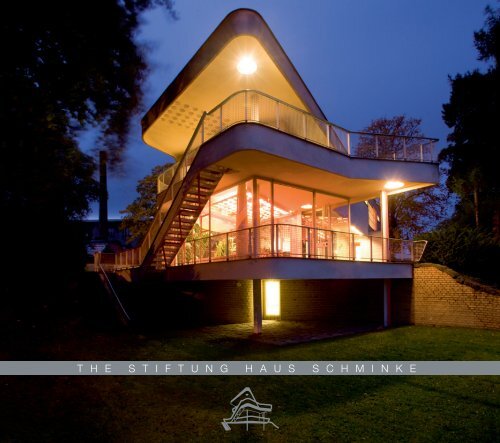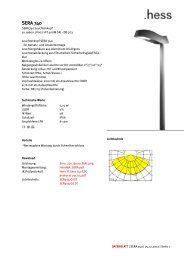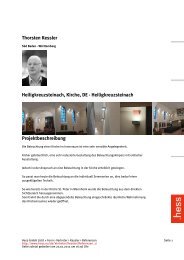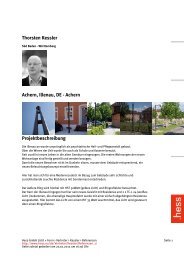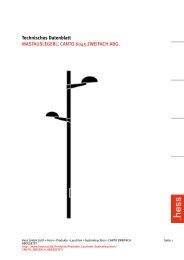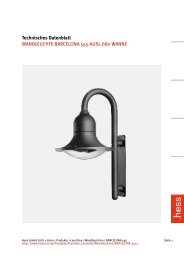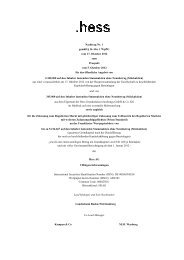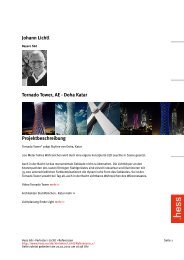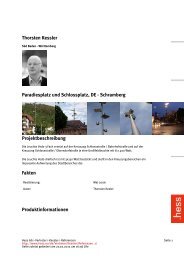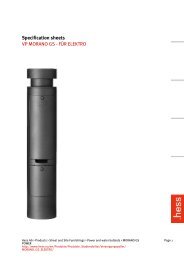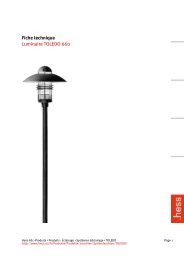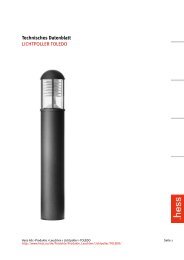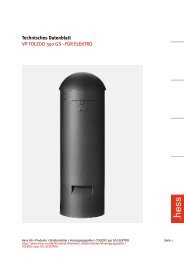T h e S T i f T u n g h A u S S C h M i n K e - Hess AG
T h e S T i f T u n g h A u S S C h M i n K e - Hess AG
T h e S T i f T u n g h A u S S C h M i n K e - Hess AG
You also want an ePaper? Increase the reach of your titles
YUMPU automatically turns print PDFs into web optimized ePapers that Google loves.
T h e S T i f T u n g h A u S S C h M i n K e
T h e S T i f T u n g h A u S S C h M i n K e
Basement ground floor upper floor<br />
„The house built by factory owner Schminke from Loebau, Saxony, remained my favorite one.“ hans Scharoun
The Modernity –<br />
still inspiring: now and in the future<br />
There is an outstanding example of a benchmark of architecture<br />
in Loebau, Saxony: it’s the haus Schminke. it was<br />
built in the beginning of the nineteen-thirties for the family<br />
and factory owners Schminke by the architect hans<br />
Scharoun and it is still one of the most important residential<br />
This brochure was kindly supported by the hess group.<br />
P r o L o g u e<br />
buildings of the 20th century. The Stiftung haus Schminke,<br />
a charitable foundation, has made it their mission to<br />
preserve this outstanding architectural monument as a<br />
testimony of the “new Building” for future generations.
Dear friends of the Haus Schminke,<br />
The formation of the Stiftung haus Schminke, a charitable foundation, was an important decision to all of us of the grosse<br />
Kreisstadt (greater District Town) of Loebau and we are sure it is the right way to preserve the “favorite house” by the<br />
architect and professor hans Scharoun as a heritage for future generations.<br />
A charitable foundation is one option to permanently ensure financing and operation of a cultural condition. Thus, it is<br />
possible to maintain what is important to many people: The haus Schminke is precious and close to the hearts of many<br />
citizens. The Stiftung haus Schminke has been capable of holding rights since May 2009 and will concentrate its attention<br />
to this architectural monument which is famous all over the world. Activities are also a contribution to the so-called<br />
“Cultural route” running from Dresden to upper Lusatia, which makes our region even more attractive to visitors.<br />
At this point, i would like to thank the hess Ag for special engagement and i would like to point out that such initiative<br />
would not be possible without and is based on their entrepreneurial success. The hess Ag as a founder contributes to<br />
the monument becomes well known far beyond the region: Who could better do than a business which acts world-wide<br />
itself?<br />
external donation will be necessary for the charitable foundation in order to fulfill its manifold challenges. So, i would like<br />
to cordially invite you to support the Stiftung haus Schminke.<br />
Dietmar Buchholz<br />
Lord Mayor of the City of Loebau<br />
g r e e T
i n g S<br />
Dear Sirs,<br />
The city of Loebau has an architectural gem of international importance, the haus Schminke. This entails a special<br />
commitment and steady challenge of preserving this monument, which exceed the scope of public authorities. i think, it<br />
is not just about financial dimensions but also to ensure by ideational engagement the monument permanently earns its<br />
importance and due appointment among architects world-wide.<br />
As an enterprise resident and associated to Loebau and to the free State of Saxony, we feel responsible to contribute the<br />
haus Schminke is maintained. We are also enthused by the clear, minimalist design vocabulary and the exemplary way the<br />
house was complemented into its natural environment. As we are a producer of lamps and street lanterns, architecture has<br />
always been our guideline and inspiration. further generations will be reemployed by the haus Schminke as a milestone<br />
of modern architecture.<br />
The city of Loebau and the hess Ag, as the founders, laid the cadre and it will now be important to put the charitable<br />
foundation on a firm footing and financially wide base. Therefore, we need external donation from enterprises, public and<br />
private institutions and citizens.<br />
hoping you will assist us.<br />
Christoph <strong>Hess</strong><br />
Ceo of hess Ag
The haus Schminke, built in the nineteen-thirties, is one of<br />
four outstanding examples of the styles “new Architecture”<br />
and “international style” (architecture). its importance<br />
ranks among e. g. haus Tugendhat by Mies van der rohe<br />
which is in Brno, Czech, Villa Savoye in Poissy near Paris<br />
by Le Corbusier and the haus Kaufmann “fallingwater” in<br />
Mill run, Pennsylvania, by frank Lloyd Wright. All these<br />
houses were customized to meet their owners’ needs as<br />
well as the need to complement the natural environments<br />
by impressive solutions. As early as 26 years after<br />
completion, the haus Schminke was considered to be of<br />
a revolutionary style and recorded as a historical memorial<br />
of the Modernity, thus finally listed under monument<br />
conservation law in 1978.<br />
hans Scharoun designed the house for the noodle<br />
manufacturer fritz Schminke from Loebau in 1930. The<br />
owner wanted “… a modern house for two parents,<br />
four children and one or two occasional guests…” The<br />
realization is both, fancy and functional. The curved<br />
corpus with its terraces, external staircase and numerous<br />
H a u s s c H m i n k e<br />
porthole-shaped windows provide the impression of a<br />
ship image. rooms merge flowingly; generous grasslands<br />
involve the garden as an extension of living space as<br />
well. Beside span and lucency, manifold design elements<br />
form the spatial experience. Developed especially for the<br />
house, their colors and shapes set outstanding courses. in<br />
contrast, utility rooms – including a frankfurt kitchen – and<br />
the sleeping area remain sparse by intention and include<br />
easy to clean surfaces and space-saving built-in closets.<br />
herta hammerbacher designed the garden as a dynamic<br />
connection between architecture and landscape. Basic<br />
design and materials of structural elements were continued<br />
into the garden in order to generate a composition of<br />
both organic and inorganic. This design approach was<br />
a very typical one by the landscape architect herta<br />
hammerbacher, who had previously worked with the Karl<br />
foerster and hermann Mattern “Arbeitsgemeinschaft<br />
gartengestaltung” (a landscape gardening consortium) for<br />
more than two decades.
A V i V i D e V i D e n C e o f T h e M o D e r n i T Y<br />
A changeful history<br />
The Schminke family lived in the house for only 12 years.<br />
in 1945, the russian red Army confiscated the house.<br />
The expropriation by the former gDr state followed in<br />
1952. it was used as a “haus der Pioniere” (“house for the<br />
Pioneers”, the former official communistic organization for<br />
children) until 1989 and as a holiday center after german<br />
reunification. The three daughters of Charlotte and fritz<br />
Schminke, gertraude Bleks, erika inderbiethen and helga<br />
Zumpe, generously abstained from restitution of their<br />
parents’ house in 1993 subject to future further public use<br />
which paved the way for making the house accessible as<br />
an architectural monument.<br />
Decades of third-party use left deep traces to the house.<br />
reconstruction works, supported by the city of Loebau<br />
and the Wuestenrot foundation, brought several details to<br />
light that had been lost. Among others, there were some<br />
old photographs of the house’s construction. So, one<br />
could identify some of the original interior design as e. g.<br />
a sofa where all the four kids strung together could have<br />
their siesta. Several lamps and the original fireplace were<br />
found when the garden pond was reconstructed. Thanks<br />
to Charlotte’s and fritz’ Schminke’s daughters, more and<br />
more original objects returned to their places of origin as<br />
e. g. the sofa in the bedroom, mother’s marital bed, a<br />
scribe and some private books.<br />
Since its reopening in 2001, the haus Schminke has<br />
been open for tours and has attracted visitors interested<br />
in history and architecture. it is also possible to book<br />
the house for seminars, concerts or evening readings.<br />
A special experience of staying overnight is offered to<br />
smaller groups.<br />
To secure the future<br />
The Stiftung haus Schminke took sponsorship for the<br />
architectural monument in May 2009. from now on, the<br />
focus is fully on maintenance and needs of the haus<br />
Schminke, as e. g. exploration and reconstruction of original<br />
conditions as well as enhancement of conceptions of using<br />
the house. The goal is to meet concerns of its importance<br />
in an optimal way from architectural, cultural and historical<br />
points of view. The foundation has own responsibility<br />
regarding assignment of funds which provides purposive<br />
action while considering current needs.<br />
You, as a sponsor, will contribute to the haus Schminke<br />
will remain as an object of cultural value for the current and<br />
following generations. A one-time sponsorship will help to<br />
ensure the future existence of the haus Schminke as one of<br />
the architectural most important buildings of the region.
h A n S S C h A r o u n – o n e o f T h e g r e A T e S T<br />
hans Scharoun is to be mentioned among the most<br />
important representatives of the so-called organische<br />
Architektur (organic Architecture), a movement within the<br />
classical modernist art. he always sought the functional<br />
correlation between a building and its territory. The idea<br />
behind this was to develop a building design from its<br />
implicated function in an “organic” way.<br />
Scharoun was born in Bremen in 1893 and grew up in<br />
Bremerhaven. So, seaport impressions contributed to his<br />
personal style. They are reflected in many of his buildings:<br />
Porthole-shaped windows, steel steps and rails, railingshaped<br />
balustrades and balconies are typical elements<br />
also to be found with the haus Schminke.<br />
hans Scharoun studied architecture and building trade<br />
at the Tu Berlin-Charlottenburg (Technical university)<br />
from 1912 to 1914. After this, he worked with the office<br />
of his mentor Paul Kruchen in insterburg until he became<br />
appointed a professor to the “Staatliche Akademie fuer<br />
Kunst und Kunstgewerbe” (Public Academy for Arts and<br />
Crafts) Breslau (Wroclaw) in 1925. The one-family dwelling<br />
in Stuttgart Weissenhofsiedlung (Weissenhof estate, also<br />
Weissenhof Settlement), built in 1927, and the residential<br />
home for the Breslau Werkbundausstellung, built in 1929,<br />
as well as the large housing estate Siemensstadt, Berlin,<br />
planned from 1929 to 1931, were trend-setting and<br />
expressed an example of his way of executing socially<br />
acceptable house buildings.<br />
When the nazis came into power, modernist architecture<br />
and arts came to an end. Most leading architects of<br />
“neues Bauen” (new Building) emigrated. Scharoun stayed<br />
but he was excluded from public contracts. he found a<br />
market niche in developing dwelling houses: Where facing<br />
a road, they “camouflaged” in their formal vocabulary of<br />
architecture. Scharoun fixed his architectural ideas in<br />
numerous water-colors continued to prepare himself for<br />
the time after the nazis’ governance.<br />
The Soviets’ Military Administration appointed Scharoun<br />
to a Planning Director and head of the Construction and<br />
housing Department of the Municipality of gross-Berlin<br />
(greater Berlin). he presented his conception on how to<br />
reconstruct Berlin at an exhibition which took place in<br />
the White hall of the Berlin City Palace. Scharoun himself<br />
called his intention a “Kollektivplan” (collective plan). The<br />
plan was not just to rebuild but to basically reorganize<br />
the urban space. finally, competitive conceptions were<br />
executed, due to limited financial and technical resources,<br />
as well as the beginning of the splitting of the town. All of<br />
the conceptions were influenced by Scharoun’s drafts.
M A S T e r - B u i L D e r S o f T h e 2 0 T h C e n T u r Y<br />
Scharoun was appointed a full professor at the Technical<br />
university of Berlin in 1947. he taught there until 1958.<br />
from 1947 to 1950, he also was a Director of the institute<br />
for Civil engineering with the Deutsche Akademie der<br />
Wissenschaften (german Academy of Sciences) in<br />
hannoversche Strasse, east-Berlin, where he developed<br />
the attic. in 1973/1974, the building became the office of the<br />
“Staendige Vertretung der Bundesrepublik Deutschland bei<br />
der DDr” (West german representation in east germany).<br />
Today, it is the Berlin office of the federal Ministry of<br />
research and education. The crowning achievement of<br />
his works after World War ii was the Berliner Philharmonie.<br />
it is calculated according to its utilization thus, a paradigm<br />
for organic Architecture. Scharoun’s intention was “… to<br />
give adequate forming to a place of playing music and<br />
commonly experiencing it”. herrmann Mattern, who had<br />
been introduced to Scharoun by his wife and garden<br />
designer herta hammerbacher, designed the outside<br />
facilities of the Berliner Philharmonie.
E X P E R I E N C E S C H A R O U N ’ S F A V O R I T E B U I L D I N G<br />
Thousands of visitors from all over the world come to<br />
Loebau each year in order to view the haus Schminke.<br />
not just for architects: More and more cultural tourists<br />
are increasingly interested in a guided tour and enjoy it<br />
very much. A guest-night at the haus Schminke is a very<br />
special and unforgettable experience.<br />
Guided Tours<br />
A guided Live Tour in german is possible at any time during<br />
opening hours. We kindly ask you to advise us prior to any<br />
group tours. You may also enjoy an Audio-guided house<br />
Tour in german or english.<br />
Guest-nights<br />
Are you an architect, an architectural student or just<br />
interested in modern architecture? Do you just want to<br />
experience the haus Schminke quality of life? Then, just<br />
seize the opportunity and stay overnight.<br />
There is also opportunity, especially offered to larger<br />
college and university study groups, to have a guest night<br />
at the haus Schminke.<br />
Events<br />
The house is an ideal place to discuss about architecture,<br />
urban layout or history of the arts. it also provides a unique<br />
framework for a concert, evening reading or to hold a<br />
reception. We will have pleasure in providing advice and<br />
arranging the event at your option.<br />
Opening hours<br />
every day except Mondays: March to october 10 a.m. -<br />
5 p.m., november to february 1 p.m. - 5 p.m.<br />
Please, check opening hours with again prior to your<br />
arrival, as we occasionally close for several special events.<br />
for contact, registration, directions and entrance fees<br />
please, see our website: www.stiftung-hausschminke.eu.
W e L L W o r T h S e e i n g<br />
A visit to the haus Schminke can be completed to a unique<br />
culture tour. A popular starting point is Dresden, capital<br />
of the free State of Saxony, with its international airport.<br />
The “City of Culture and Arts” is considered as one of<br />
europe’s most beautiful cities. Visitors are impressed by<br />
inimitable baroque and renaissance style buildings as e. g.<br />
Dresdener Zwinger Palace, the Dresden residence Castle,<br />
the Semper opera house and the Dresden frauenkirche<br />
(Church of our Lady). raffael’s bold two putti of the Sistine<br />
Madonna of Dresden’s Art Collections’ are advertised<br />
throughout the world.<br />
A cultural route from Dresden to Upper Lusatia<br />
following the route, visitors arrive Bautzen, a city that<br />
is more than 1000 years old is also called “The heart of<br />
upper Lusatia”. Bautzen is one of the cultural centers of<br />
the Wends and mainly known for its old Town with more<br />
than 13 towers, many churches, ortenburg Castle as well<br />
as the many, many alleyways have retained Bautzen’s<br />
medieval character to date.<br />
Traveling further eastwards, you’ll arrive Loebau which<br />
is in 85 km distance from Dresden. Apart from the<br />
haus Schminke, the historic center, which has been<br />
reconstructed affectionately, and the cast-iron tower on<br />
the local landmark mountain, unique throughout europe,<br />
both are worth a visit, too.<br />
in Zittau, 30 km from Loebau, the cultural route leads<br />
you to 52 sights, representing the once richest city of the<br />
“oberlausitzer Staedtebund” (Six Cities’ Alliance of upper<br />
Lusatia).<br />
By the river neisse, the german-Polish national border,<br />
there is the european City goerlitz/Zgorzelec with its<br />
almost 4,000 monuments from 500 years of european<br />
building history which ranges from gothic, renaissance, to<br />
Wilhelminian Style and Art nouveau Style. The city became<br />
an uneSCo World heritage Site because of the unique<br />
character of its interrelated townscape.<br />
on both sides of the river neisse, the Muskauer Park<br />
dispreads on more than 830 hectares throughout the<br />
landscape of Lusatia. This park was designed by hermann<br />
fuerst von Pueckler-Muskau in 1815. it is a worldwide<br />
unequalled masterwork of landscape design and has been<br />
an uneSCo World heritage Site since 2004.
W e L L W o r T h S e e i n g<br />
The Path of “Die Moderne” (Modernity)<br />
A visit to the Bauhaus with attached masters’ buildings<br />
by Walter gropius in Dessau (distances: 130 km to Berlin,<br />
250 km to Loebau) is a must for an enthusiast of the<br />
Modernity. Today, the “Bauhaus Dessau is a vivid place for<br />
experimental designing, research and teaching again.<br />
from Loebau, it is just a few minutes by car to visit the<br />
Wachsmannhaus in niesky, which is one of the most<br />
important architectural evidence of the Moderne. it was built<br />
as a Director’s apartment house by the Architect Konrad<br />
Wachsmann in 1927. Konrad Wachsmann is considered<br />
worldwide as the pioneer of industrial building.<br />
if you go to Brno (Bruenn), Czech republic, there is the<br />
house Tugendhat waiting for you, a masterpiece of classic<br />
modern architecture and the most important building by<br />
Ludwig Mies van der rohe in europe. When built in the<br />
1920s, the Moravian metropolis had already become a<br />
center of the avant-garde of architects.<br />
Search for traces of Hans Scharoun<br />
There is no better city of being aware hans Scharoun’s<br />
producing than Berlin. Siemensstadt, which he designed,<br />
has become a symbol of modern domestic construction<br />
of the Weimar republic period. The Berliner Philharmonie,<br />
opened up in 1963, is considered as the most important<br />
work by hans Scharoun and as an example of an “organic<br />
building”.<br />
Traveling from Berlin via Loebau, the Polish Breslau<br />
(Wroclaw), 200 km from Loebau is worth a visit. it s also<br />
called the “Polish Venice”, because of its numerous bridges<br />
and footbridges. Apart from other buildings characterizing<br />
the architecture of the new Building, the home for single<br />
persons by Scharoun is well worth seeing.<br />
for further information please visit:<br />
www.stiftung-hausschminke.de
hess gratuliert the zur hess gründung grOuP der cOngratulates stiftung haus schminkeOn<br />
estaBlishment Of the charitaBle<br />
fOundatiOn haus schminke<br />
www.hess.eu
feASiBiLiTieS hoW To SuPPorT The founDATion<br />
if you want to become an external donator, you can<br />
announce this just by using the attached Signing Cer-<br />
tificate form. Please, fill in this form completely, sign and<br />
send original signature to:<br />
Stiftung Haus Schminke<br />
Kirschallee 1b<br />
D-02708 Löbau<br />
Germany<br />
Correspondent Bank of the<br />
Stiftung Haus Schminke<br />
Sparkasse oberlausitz-niederschlesien<br />
Account holder: Stiftung haus Schminke<br />
Account number: 3000125700<br />
national Bank Code: 850 501 00<br />
iBAn: De82 8505 0100 3100 0332 71<br />
BiC: WeLADeD1grL<br />
note to payee: Stiftung haus Schminke<br />
We will contact you upon receipt of the Signing Certificate<br />
form. if you have any questions, we will have pleasure in<br />
being at your disposal for one-to-one interviews. Just call<br />
or send us an email.<br />
Stiftung Haus Schminke<br />
Katrin Schenk, Leiterin (Manageress) haus Schminke<br />
Phone: +49 (0) 35 85 / 86 21 33<br />
fax: +49 (0) 35 85 / 83 30 10<br />
email: info@stiftung-hausschminke.eu<br />
www.stiftung-hausschminke.eu<br />
Initial benefactors<br />
Stadt Löbau<br />
Altmarkt 1<br />
02708 Löbau<br />
www.loebau.de<br />
hess Ag<br />
Lantwattenstraße 22<br />
78050 Villingen-Schwenningen<br />
www.hess.eu<br />
Imprint<br />
Published by: Stiftung haus Schminke,<br />
Kirschallee 1 b, 02708 Loebau<br />
Conceptual design created by:<br />
CC Communications gmbh, Stuttgart<br />
Photographs: inspirations ganter, niedereschach


